Page
Last Updated:
EDT, © 2010, 2011, 2016
PROJECT: IW Metric Ontology
Dr. Dean S. Hartley III
| Project Metadata |
Keywords |
|
Label |
Name |
Other |
Year |
DurationYrs |
|
Client |
TRAC |
US Army |
|
|
|
Dates |
|
|
2010 |
0.75 |
|
Employer |
Hartley
Consulting |
|
|
|
|
Partner |
Dynamics
Research Corporation (DRC) |
|
|
|
|
Pubs |
"Chapter 2:
Creating the foundations for modeling irregular warfare," in
Advances in Design for Cross-Cultural Activities, Part II,
Eds. Denise M. Nicholson and Dylan D. Schmorrow, CRC Press, Boca
Raton, FL |
lead author |
2012 |
|
|
Pubs |
"Ontology
Structures for Modeling Irregular Warfare," in Military
Operations Research, Vol17, Num 2, 2012 |
author |
2012 |
|
|
Pubs |
“Developing
Human Social Cultural and Behavioral (HSCB) Ontologies to
Support Simulations," Simulation Interoperability Workshop
2011, April 2011, Orlando, FL |
co-author |
2011 |
|
|
Pubs |
"Using
Ontologies in Conceptual Model Validation," in Hawaii
University International Conferences (HUIC) Proceedings,
July 2012 |
author |
2012 |
|
|
Pubs |
Irregular Warfare (IW) Metrics Ontology Final Report.
Dynamics Research Corporation, Orlando, FL |
lead author |
2011 |
|
|
|
Configuration management |
|
Consequence Management |
|
Data Verification & Validation |
|
Database design |
|
DIME/PMESII Modeling |
|
Documentation standards |
|
Geopolitical analysis |
|
Global War on Terrorism (GWOT) |
|
Human factors |
|
Human, Social, Cultural Behavior (HSCB) Modeling |
|
Impact analysis |
|
Independent Verification & Validation (IV&V) |
|
Information storage and retrieval |
|
Irregular Warfare (IW) |
|
Knowledge Management (KM) |
|
Metadata |
|
Model/System integration |
|
Modeling, Simulation & Gaming (MSG) |
|
Ontologies |
|
Operations Other Than War (OOTW) |
|
Software issues |
|
Software reuse |
|
Stability Operations (SASO, SSTR) |
|
Verification, Validation & Accreditation (VV&A) |
|
Warfare modeling |
|
Challenge:
Support the US Army Training and Doctrine Command (TRADOC) Analysis Center (TRAC)
in developing an ontology of the metrics needed for modeling Irregular Warfare (IW).
Background:
The initiative is led by the TRADOC Analysis Center (TRAC). The
Methods, Models and Tools (MMT) aspect of the TRAC IW Analytic Capability (IWAC)
program is primarily focused on the Irregular Warfare Tactical Wargame (IW TWG).
The IW TWG is implemented as a composition of tool modules. Some of the input
data to the TWG describe the state of the operational environment and some of
the outputs describe perceptions of the population and key individuals. The Army
envisions its mission as supporting one or more Lines of Effort (LOEs), with
intermediate metrics in the PMESII spectrum to be used as indicators of success. The goal is to provide results that indicate perceptions of key
personnel and population, describe the current state of the operational
environment, and to determine progress towards the desired end state. The IWAC
program should support multiple echelons (e.g., company, battalion).
LOEs and the DIME/PMESII Paradigm:
|
The six LOEs within the current scope are the first six in the table
to the right, taken from FM3-24.2, pg 4-8, 21 April 09. Each
LOE may be thought of as a large task that can be broken into
subtasks, several of which.are included in the table. Each LOE
also has a desired endstate - which is not a task or action, but the
value of a state variable. It should be noted that these are
Department of Defense LOEs and that other parts of the government,
the parts of the relevant host nation (HN), and other interested
parties will have their own analogs to these LOEs. PMESII
variables are state variables that describe the state of the world
by dividing it into Political, Military, Economic, Social,
Information, and Infrastructure categories. These categories
are further subdivided for convenience. Each of the LOE
endstates can be placed somewhere within the set of PMESII
variables.
DIME variables represent actions that can be undertaken by a
government and are divided into Diplomatic, Informational, Military
and Economic Categories. DIME actions are generally at the
level of sub-subtasks as compared to this table. |
 |
The figure to the right illustrates one possible model connecting
DIME actions (red-colored boxes) and PMESII state variables (other
boxes). Additional annotations have been added to show the
connections to one LOE.LOE 5 is a task to provide support to
economic and infrastructure development. One DIME action that might
be employed in this task is rebuilding roads (point #1 at the top in
the figure and the circled red box on the right edge of the figure).
This model claims that this action will result in some amount of
road capacity being created, some amount of jobs being created, and
some amount of investment (point #2 and the other circled boxes on
the lower right). These variables will in turn lead to
modified HN road capacity, jobs and foreign investment (point #3 and
magenta circled boxes in the interior of the figure). If the
theory and model are correct, eventually the connections will lead
to improvement in the LOE 5 Endstate variable (blue circle at the
top of the figure). Following the model connections will also
lead to other consequences, some beneficial and perhaps some
harmful.
The figure also shows that the model connections can be followed
in reverse (points #1 & 2 at the bottom left and the three blue
circled variables). Tracking backward from the endstate
variable will identify all of the actions that could affect the
endstate. It may also identify variables that are not under
the control of a particular side that could affect the endstate. |
 |
Process:
Dynamics Research Corporation (DRC) and Hartley Consulting created a team to
address the problem, with DRC supplying the ontology expertise and Hartley
Consulting supplying the IW modeling expertise.
As shown in the figure to the right, the goal of producing an IW ontology
and linking the LOEs to PMESII Metrics was envisioned as being created through
- Workshops,
- Literature review,
- Tools review, and
- Expertise.
Literature review included a search for general concepts and
relationships from doctrine (such as Joint Publications and Army Field
Manuals), workshops (including those hosted by the Military Operations
Research Society (MORS), the National Defense University (NDU), and the
Human Social Cultural Behavior (HSCB) project), and books articles
and presentations.
In this process the team would develop
- IW definitions,
- Ontology definitions,
- LOE definitions,
- PMESII definitions,
- Metric definitions, and
- Operational knowledge.
The results would be collected into a final report that would
describe the machine readable ontology.
|
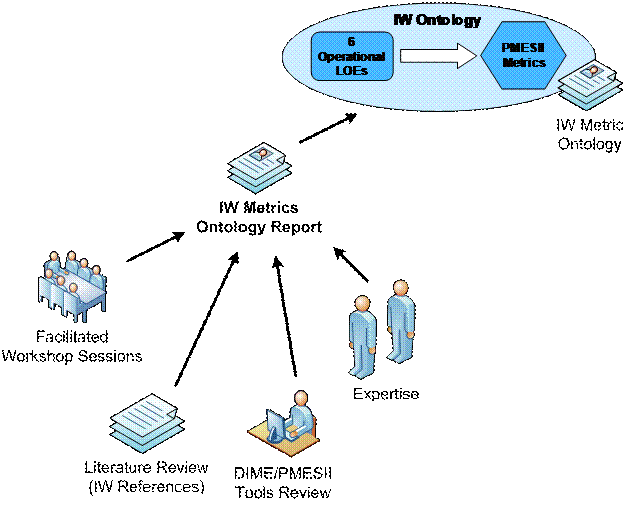 |
The ontology creation process is illustrated by the IDEF0 diagram to
the right.
Step A1 consists of scoping the problem domain, based on the
tasking.
Step A2 consists of identifying ontologies that can be reused,
based on existing ontologies and controlled by the ontology
requirements output in A1.
Step A3 consists of defining the classes and properties needed in
the IW ontology, based on the ontology reuse candidates output by A2
(and the ontology requirements).
Step A4 consists of documenting and encoding the ontology design
artifacts. |
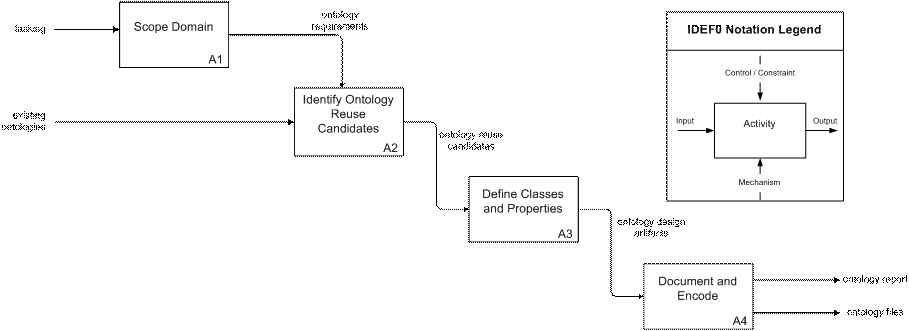 |
Ontology Background:
|
An ontology is a tool used in describing a domain of knowledge about
the world. Accordingly, it consists of vocabularies,
definitions and relations. The figure to the right, derived
from Uschold, shows a spectrum of increasingly formal descriptions
of a domain, in this case illustrated by a "pump." |
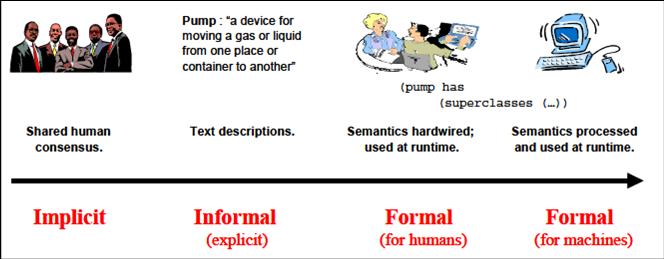 |
|
The figure to the right, taken from McGuinness, shows a spectrum of
descriptive techniques, also ranging from informal to increasingly
formal, with a dividing line indicating the general area in which a
description can be called an ontology. The "is-a" relationship
provides a separation point. Stating that a pie is a type of
dessert is an informal "is-a" relationship. A formal "is-a"
relationship requires that the vocabulary is controlled so that
"desserts" are distinguished from non-desserts, "pies" from "cakes,"
etc. |
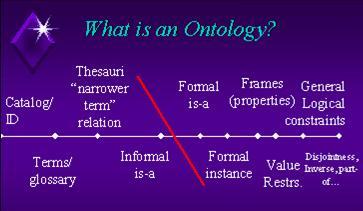 |
|
The figure to the right begins the process of describing this
formalization. The domain (for us IW metrics) is represented
by a world globe. The domain is modeled by a conceptualization that
consists of a controlled vocabulary of classes and their
relationships. The ontology specifies this conceptualization
(for instance by using a computer readable language) and thus
describes the domain.
The ontology is divided into two parts, the
Tbox elements (class names, attributes, and relations) and the Abox
elements (instances of the classes and qualifiers). As
examples: "pie" could be a class, with attributes such as definition
and definition author; "peach pie" could be a class, related to
"pie" by the "is-a" relation, with attributes such as "must contain
peaches or peach flavoring"; and a particular peach pie could be an
instance, with qualifiers such as "sell-by-date." |
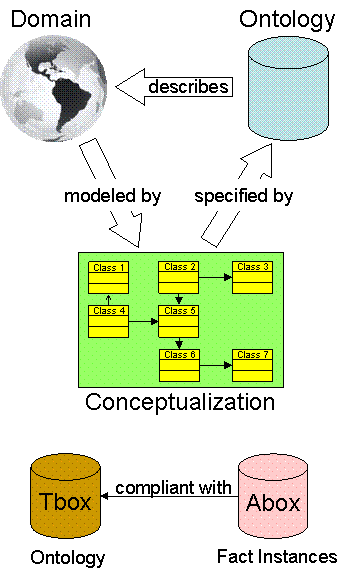 |
|
The most formal types of ontologies are encoded in some machine
readable language to permit automatic inferencing and use by general
programs. The figure to the right, derived from Lacy, shows
how an application (such as the IW Metric Ontology) is based on a
high level language, in this case the Web Ontology Language (OWL) 2.
OWL 2, in turn is based on lower level languages, down to XML (which
is a generalization of the HTML used in web pages) and IRIs
(generalizations of URLs, the location pointers for web pages).
|
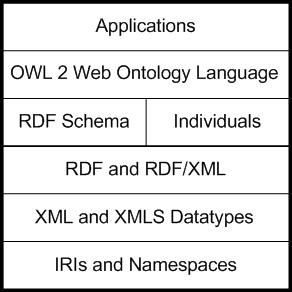 |
Technical Results:
|
The central organizational principle for the development of the IW
Metric Ontology is provided by the figure to the right. The
Operational Environment that includes everything relevant to
irregular warfare is divided into three parts: Actors, Actions, and
the Environment. Actors are human and natural entities that cause
things to happen, thereby changing things.
Actions are the interventions, events, and ongoing processes that
are performed by actors and which directly cause changes.
The Environment represents the rest of entities in the
Operational Environment.
Actors perform Actions, which affect the Operational Environment
(OE). The state of OE, including any changes, is described by State
Variables. Actors perceive the OE by means of the State Variables.
State Variables include both numeric variables (true metrics) and
categorical variables (e.g., type of government). IW Metrics
are defined to be these State Variables and provide the content of
the IW Metric Ontology. |
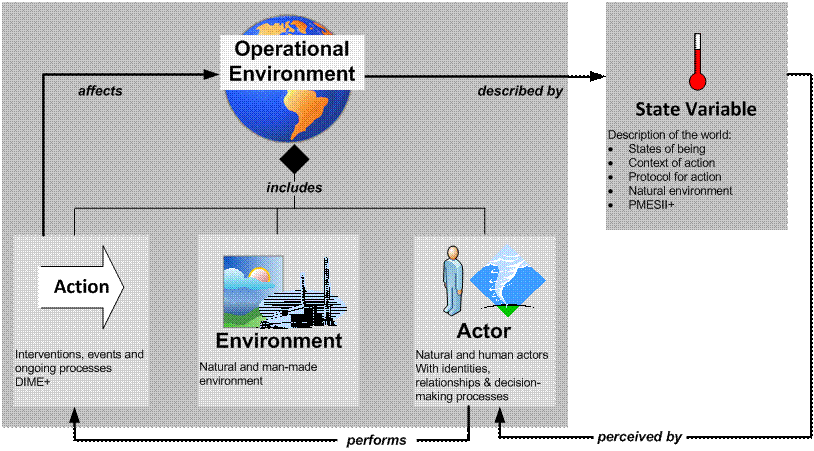 |
The formative taxonomy that was chosen was the PMESII framework
because its content includes the IW State Variables.
The initial sources for the metrics were Hayes & Sands Doing Windows, the
Interim Semi-static Stability Model (ISSM),
and the DIME/PMESII VV&A Tool. Additional
sources provided confirmation of the metrics and additional metrics.
The major additional sources were the Klein's HSCB Taxonomy, TRACs Metrics v3, the OCRS
Matrix, Hartley's Corruption in Afghanistan, TRAC's IW Decomposition, Dziedzic's
MPICE, SRI's PRIME Taxonomy, and Hilson's Requirements document (citations
below in the Literature section).The figure to the right displays the
initial taxonomic organization. The actual State Variables are
attached to the subcategories. Although this taxonomy has been
revised (so that IW Metrics relating to Actors and Actions [in
particular the direct results of DIME actions] are included), note
that even in its early state, this taxonomy extends beyond a pure
PMESII taxonomy: the Kinetic Evironment and the Natural Environment
have been added. Technically, this is a PMESII+ taxonomy;
however, for brevity, it is often referred to as a PMESII taxonomy. |
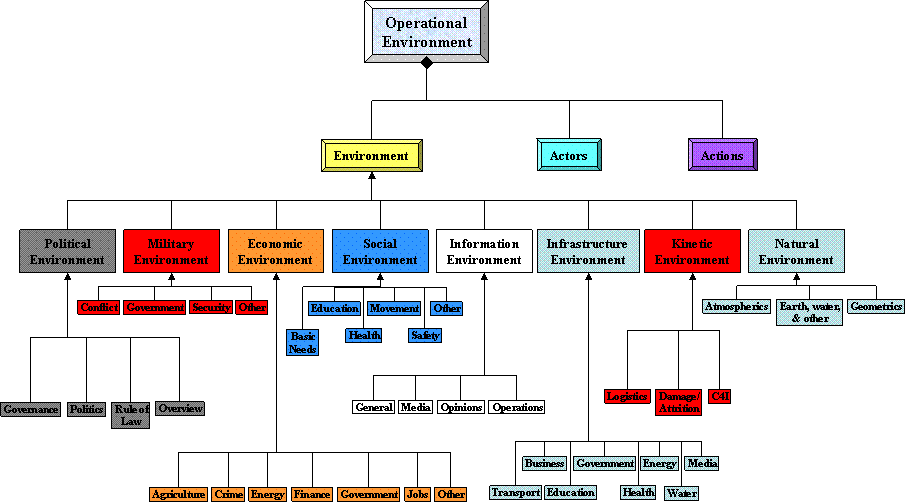 |
One of the differences between an ontology and a taxonomy is
structural and conceptual. Each element in a taxonomy can only have
a single "parent," whereas in an ontology, an element may have
multiple "parents." For example, in a taxonomy, buildings used
by a government can be placed in Government under Infrastructure
Environment or in Government under Economic Environment or in
Government under Military Environment or in some other part of the
structure, but not in more than one part. In an ontology, these
buildings may be connected to multiple "parents," as appropriate.
For example, government educational buildings would be connected to
both the Education box under Infrastructure Environment and to the
Education box under Social Environment. This means that the
attributes for the class of educational buildings can be attached to
a single class and the qualifiers for individual educational
buildings only need to be entered in one place, yet they can be
retrieved through either route.In addition to linking the IW
Metrics to multiple PMESII categories, the ontology structure allows
linking the metrics to a completely different structure - the LOE
structure, described in the Background above. Thus each direct
result of a DIME Action can be linked to the appropriate LOE or LOEs.
Further, the other metrics can also be linked to the LOEs.
This supports the goal of providing information connecting the state
of the OE to progress toward achieving the desired endstate or
endstates.
Another difference between ontologies and taxonomies is useful in
making the creation process easier. Previously defined ontologies
can be included, reducing the need to create structures. For
example, the Dublin Core Ontology, partially illustrated in the
figure to the right, provides a structure for defining the
Attributes of the classes and the Qualifiers of the instances. The
IES Ontology, created for TRAC by another project provides another
example of connecting ontologies. The IES Ontology doesn't
provide structures that the IW Metric Ontology needs; however, it
provides additional content covering general infrastructure.
Because it is an ontology, it can be linked to the IW Metric
Ontology, increasing the value of both ontologies. |
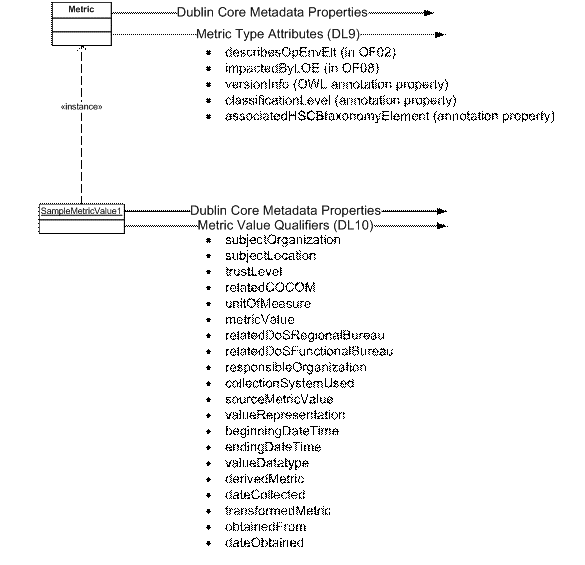 |
During the creation of the ontology, the team used a set of Excel
spreadsheet to collect and organize the information as it was
created (steps A1, A2, and A3).In step A4, the spreadsheets were
first converted to a database, making explicit the multiple parent
relationships that could only be represented by text comments in the
spreadsheets. The database was converted to OWL ontology files using
a DRC tool (the DOAT Database tool), as illustrated in the figure to
the right. |
 |
|
The logical structure of the OWL files is illustrated in the figure
to the right. The gray block on the left represents the PMESII+
structure (in part). The superclass
OperationalEnviornmentCharacteristics is a subclass of the Metrics
class and has the various PMESII categories and subcategories as
subclasses, so they inherit the attributes of a general metric. The
actual metrics (such as FreedomRating) are subclasses of the general
metric class, as well as being subclasses of the appropriate
subcategory class(es). The metrics are also properties of the
appropriate LOEs. Each metric also has as subclasses the source-data
classes, which have instance data. |
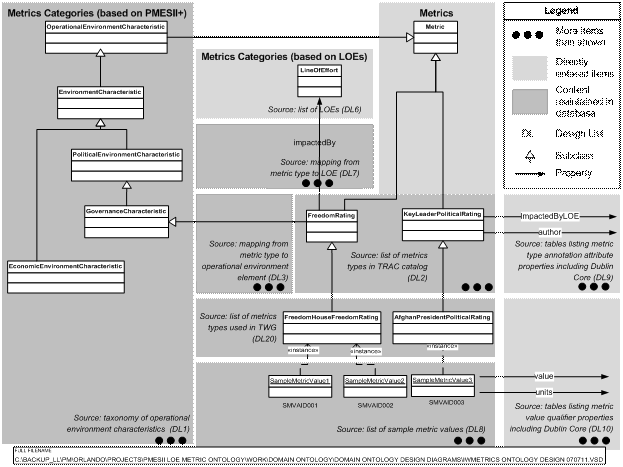 |
|
The figure to the right illustrates the physical structure of the
OWL ontology files. This physical modularization makes it easier for
application developers to import only the portions of the ontology
that they need and separates common information into single files. |
 |
Operational Results:
During the project workshops, TRAC used the ontology in several ways.
- Army personnel examined each metric element for connections to the
LOEs.
- This process generated suspected primary, secondary and tertiary
connections between each element and the set of LOEs.
- The process also provided subject matter validation of the
metric elements.
- And the process familiarized the TRAC team with the details of
the ontology.
- Army personnel examined each metric element for utility
concerning the IW TWG.
- The first question was, "is this element already addressed
by the TWG?"
- The second question was, "if not, should it be added to next
year's improvements list?"
- The third question was, "if not, should it be added to the
'wish list'?"
- Army personnel created analogs of the LOES for participants
other than DoD (e.g., the Host Nation, the Department of State,
the adversary) and connected them to the metric elements.
Conclusions:
Developing the IW
Metrics ontology resulted in a series of technical conclusions. These
include:
-
Metrics serve as State Variables;
-
Domain decomposition is required for defining metrics;
-
IW Operational Environment domain is difficult to scope;
-
Modeling assumptions are required for full semantic use;
-
OWL can be used to formalize the IW Metrics Ontologies;
and
-
OWL Ontologies must be modularized and related to
support partial reuse.
Additionally, there are communications and other benefits
including:
-
Defining
a controlled vocabulary supports clear communications;
-
The ontology formalizes portions of the conceptual model;
and
-
Extending the ontology (see recommendations) will yield additional benefits.
Recommendations:
The team advised TRAC that several steps can be taken to beneficially
extend the results.
Identify and document use cases, such as the following:
-
Define what should be modeled: use the metric types of
the ontology to identify which concepts should be included in a
particular model;
-
Help define needed data: use the metric types of the
ontology to identify the data that will be needed to support a
particular model;
-
List of LOE related metric types: use a model that
causally or inferentially connects the metric types of the ontology to
define which metrics are connected to a given LOE or to a subset of
tasks for a given LOE;
-
Create LOEs for other parties of a conflict: use the
DoD LOEs and their connections to the ontology as a model for creating
LOEs for other parties;
-
Support the analysis of the results of a model
execution: use the ontology to identify significant results and
connections among the results of a model execution;
-
Enhance communication during war game execution: use
the ontology to identify meaningful metric values to pass among the war
game players;
-
Support VV&A: use the ontology to identify the
significant components of a model and the theoretical underpinnings of
the components; and
-
Help identify relevant metrics based on a model: use
the metric types of the ontology to identify the metrics of a particular
model that relate to each metric type.
Perform additional ontology work, such as the following:
- Formally create the Actor, Action and Environment ontologies implied
in the Operational Environment diagram, supporting completeness checking
of the Metric Ontology; and
- Create semantic relationships for the Metric Ontology, allowing
computer inference of the connections among metrics (e.g., current
bridge capacity, building bridge capacity, and damaging bridge
capacity).
This additional ontology work was performed as an IR&D project in
Total IW Ontology.
Literature:
Doctrine
US Government COIN Guide
IW Joint Operating Concept
JP 3-24
Joint Doctrine Pub 3-40
FM 3-0
FM 3-24
FM 3-07
FM 3-07.1
FM 3-24.2
CALL Leader’s Handbook 07-27
CALL PRT Playbook
Lexicon
JP 1-02, DoD Dictionary of Military and Associated Terms
Some terms identified as part of Capabilities Based Planning
Some terms identified as part of MORS workshops
Other terms will be defined as part of ontology development effort
Subject Matter - Books
Davies, J. L. & Gurr, T. R., (Eds.) (1998). Preventive Measures:
Building Risk Assessment and Crisis Early Warning Systems.
Lanham, MD: Rowan & Littlefield.
Galula, D. (1964). Counterinsurgency Warfare: Theory and Practice.
Westport, CN: Praeger Secutity International.
Gilbert, N. & Troitzsch, K. G. (2005). Simulation for the Social
Scientist (2nd ed).Glasgow, U.K.: Bell & Bain.
Grady, R. B., & Caswell, D. L. (1987). Software Metrics:
Establishing a Company-Wide Program. Englewood Cliffs, NJ:
Prentice-Hall.
Hayes, B. C., & Sands, J. I. (1998). Doing Windows:
Non-Traditional Military Responses to Complex Emergencies.
Washington D.C.: CCRP.
Kaner, S., Lind, L., Toldi, C., Fisk, S., & Berger, D. (2007).
Facilitator’s Guide to Participatory Decision-Making (2nd ed.).
San Francisco: Jossey-Bass.
Kilcullen, D. (2010). Counterinsurgency. New York: Oxford.
Nelson, R. B., & Wallick, J. (1994). The Presentation Primer:
Getting Your Point Across. New York; Irwin.
Orr, R. C. (Ed) (2004). Winning the Peace: An American Strategy
for Post-Conflict Reconstruction. Washington, D.C.: Center for
Strategic and International Studies.
Rumbaugh, J., Blaha, M., Premerlani, W., Eddy, F., & Lorensen, W.
(1991). Object-Oriented Modeling and Design. Englewood
Cliffs, NJ: Prentice Hall.
Salmoni, B. A. & Holmes-Eber, P. (2008). Operational Culture for
the Warfighter: Principles and Applications. Quantico, VA:
Marine Corps University.
Schwarz, R., (2002). The Skilled Facilitator New & Revised: A
Comprehensive Resource for Consultants, Facilitators, Managers,
Trainers, and Coaches. San Francisco: Jossey-Bass.
Sharp, E. B. (Ed.) (1999). Culture Wars & Local Politics.
Lawrence, KS: University Press of Kansas.
Wilkinson, M. (2004). The Secrets of Facilitation: the S.M.A.R.T.
Guide to Getting Results with Groups. San Francisco: Jossey-Bass.
Zeigler, B.P., Praehofer, H., & Kim, T. G. (2000). Theory of
Modeling and Simulation (2nd ed.). New Delhi, India: Harcourt
India.
Subject Matter - Papers and Presentations
Alberts, D. S., & Hayes, R. E. (2003). Power to the Edge:
Command…Control… in the information Age. Washington D.C.: Command
and Control Research Program.
Bachman, J. A., & Harper, K. A. (Nov 2007). A Toolkit for Building
Hybrid, Multi-Resolution PMESII Models. Rome, NY: Air Force Research
Laboratory.
Canada (2010). Canada’s Engagement in Afghanistan: Quarterly Report
to Parliament For the Period of April 1 to June 30, 2010. Canada:
Government of Canada.
Challand, LT COL T. (2009). Tipping Sacred Cows: Moral Potential
Through Operational Art. Military Review, Sept-Oct 2009, pp. 19-28.
Jack (2009, 5 Aug). Analyzing Populations in Stability Operations
using Cultural Geography. Monterey, CA: U.S. Army TRADOC Analysis
Center.
Kilcullen, D. (2007). Counterinsurgency in Iraq: Theory and
Practice. A seminar at the Marine Corps Base at Quantico, VA, Sept
26, 2007.
Mandrick, MAJ W. S. (2008). The Ontology of Counterinsurgency. Paper
presented at the annual meeting of the MPSA Annual National
Conference, Chicago, IL, Apr 03, 2008. http://www.allacademic.com/meta/p267785_index.htm
Mansoor, COL P. R., & Ulrich, MAJ M. S. (Oct 2007). Linking Doctrine
to Action: A New Coin Center-of-Gravity Analysis. Fort Leavenworth,
KS: Army Combined Arms Center, Army & Marine CounterInsurgency
Center.
McCrabb, Maris. (2001). Effects-Based Operations: An Overview. 52
slides. Available online at: http://www.dtic.mil/jointvision/ideas_concepts/ebo.ppt
or under ‘Internet Resources’ at http://www.au.af.mil/au/aul/bibs/ebo.htm
a January 2008 Maxwell AFB, AL, site.
Smith, J. R., Young, W. C., et. al. (2009, Aug 4). Requirements for
a Government Owned DIME/PMESII Model Suite. Presentation.
Taxonomies and Metrics
Abdollahian,
Mark, Jacek Kugler, Brice Nicholson, and Hana Oh, "Politics
and Power," Estimating Impact: A Handbook of Computational Methods and
Models for Anticipating Economic, Social, Political and Security Effects
in International Interventions, A. Kott and G Citrenbaum, eds. Springer,
New York. 2010.
Bennett, William H. "Media and Influence," Estimating Impact: A
Handbook of Computational Methods and Models for Anticipating Economic,
Social, Political and Security Effects in International Interventions,
A. Kott and G Citrenbaum, eds. Springer, New York. 2010.
Bhavnani,
Ravi, Dan Miodownik, and Rick Riolo, "Groups and Violence,"
Estimating Impact: A Handbook of Computational Methods and Models for
Anticipating Economic, Social, Political and Security Effects in
International Interventions, A. Kott and G Citrenbaum, eds. Springer,
New York. 2010.
Duong, Deborah, Robert Turner, and Karl Selke, "Crime and Corruption,"
Estimating Impact: A Handbook of Computational Methods and Models for
Anticipating Economic, Social, Political and Security Effects in
International Interventions, A. Kott and G Citrenbaum, eds. Springer,
New York. 2010.
Dziedzic, Michael, Barbara Sotirin, and John Agoglia, Measuring
Progress in Conflict Environments (MPICE): A Metrics Framework for
Assessing Conflict Transformation and Stabilization, Version 1.0. US
Institute for Peace, Washington, DC. 2008.
Hayes, Bradd C. and Jeffrey I. Sands,
Doing Windows: Non-Traditional
Military Responses to Complex Emergencies. CCRP,
Washington, DC. 1998.
Hartley III, Dean S. Operations Other Than War (OOTW) Flexible
Asymmetric Simulation Technologies (FAST) Prototype Toolbox: ISSM v4.00
Analysts' Guide. DRC, Orlando, FL. 2006.
Hartley III, Dean S. DIME/PMESII VV&A Tool (Software). Hartley
Consulting, Oak Ridge, TN. 2009.
Hartley III, Dean S. "Corruption in Afghanistan: Conceptual Model," 21
August 2010
Haskins, Casey "A Practical Approach to Cultural Insight,"
Military Review, Sept-Oct 2010.
Hilson,
Roger et al., Requirements for a Government Owned DIME/PMESII
Model Suite. Office of the Secretary of Defense Modeling & Simulation
Steering Committee, Washington, DC. 2009.
Jonker,
David and William Wright, "Visualization and Comprehension,"
Estimating Impact: A Handbook of Computational Methods and Models for
Anticipating Economic, Social, Political and Security Effects in
International Interventions, A. Kott and G Citrenbaum, eds. Springer,
New York. 2010.
Kilcullen, David Counterinsurgency. Oxford University
Press, New York, NY. 2010.
Klein, Gary,
HSCB Taxonomy, Mitre
Kott,
Alexander and Bruce Skarin, "Insurgency and Security," Estimating
Impact: A Handbook of Computational Methods and Models for Anticipating
Economic, Social, Political and Security Effects in International
Interventions, A. Kott and G Citrenbaum, eds. Springer, New York. 2010.
Lofdahl,
Corey "Governance and Society," Estimating Impact: A Handbook
of Computational Methods and Models for Anticipating Economic, Social,
Political and Security Effects in International Interventions, A. Kott
and G Citrenbaum, eds. Springer, New York. 2010.
Office of the Coordinator for Reconstruction and Stabilization,
"Post-Conflict Reconstruction Essential Tasks." US Dept of State,
Washington, DC. 2005. http://www.crs.state.gov/index.cfm?fuseaction=public.display&id=10234c2e-a5fc-4333-bd82-037d1d42b725
SRI, PRIME Taxonomy
TRAC,
IW Decomposition Analytic Strategy, Overview Briefing for IW WG, 6
January 2009
TRAC,
Metrics v3.xls
Young, William C. and Jerry R. Smith, "Requirements for Modeling DIME
Actions and PMESII Effects" presented at FOCUS 2010 Conference. 2009.
Ontology Technology
Allemang, D., & Hendler, J. (2008). Semantic Web for the
Working Ontologist: Effective Modeling in RDFS and OWL.
Burlington, MA: Elsevier.
Baader, F., Calvanese, D., McGuinness, D. L., Nardi, D., &
Patel-Schneider, P. F. (Eds) (2010). The Description Logic
Handbook: Theory, Implementation and Applications (2nd ed.).
Cambridge, UK: Cambridge University.
Daconta, M. C. (2007). Information As Product: How to Deliver the
Right Information, To the Right Person, At the Right Time.
Denver, CO: Outskirts.
Fensel, D., Hendler, J., Lieberman, H., & Wahlster, W. (Eds) (2003).
Spinning the Semantic Web. Cambridge, MA: MIT.
Lacy, L. W. (2005) Owl: Representing Information Using the Web
Ontology Language. Victoria, B.C: Trafford
Uschold, M. (2003). Where are the Semantics in the Semantic Web?
Artificial Intelligence, 24(3), 25-36.
Sharing Results:
The team presented its work in several venues during and after the project, as
shown below.
"LOEs
and the TRAC IW Metric Ontology," MORS Symposium, June 2011, Monterey, CA.
"Developing
Human Social Cultural and Behavioral (HSCB) Ontologies to Support Simulations,"
Simulation Interoperability Workshop 2011, April 2011, Orlando, FL .
"Irregular
Warfare (IW) Metrics Ontology," HSCB Focus 2011, February 2011, Washington,
DC.
"IW
Ontologies," INFORMS Annual Meeting, Charlotte, NC, 13-16 Nov 2011.
If you arrived here using a keyword shortcut, you may use your
browser's "back" key to return to the keyword
distribution page.
 Return to Hartley's Projects Page
Return to Hartley's Projects Page














